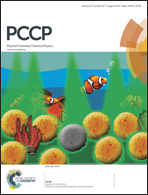Near constant loss regime in fast ionic conductors analyzed by impedance and NMR spectroscopies
Abstract
Universal dielectric response (UDR) and nearly constant loss (NCL) dispersive regimes have been investigated in fast ion conductors with perovskite and NASICON structure by using NMR and impedance spectroscopy (IS). In this study, the electrical behavior of La0.5Li0.5TiO3 (LLTO-05) perovskite and Li1.2Ti1.8Al0.2(PO4)3 (LTAP0-02) NASICON compounds was investigated. In both systems a three-dimensional network of conduction paths is present. In the Li-rich LLTO-05 sample, lithium and La are randomly distributed on A-sites of perovskites, but in LTAP0-02 Li and cation vacancies are preferentially disposed at M1 and M2 sites. In perovskite compounds, local motions produced inside unit cells are responsible for the large “near constant loss” regime detected at low temperatures, however, in the case of NASICON compounds, local motions not participating in long-range charge transport were not detected. In both analyzed systems long-range correlated motions are responsible for dc-conductivity values of ceramic grains near 10−3 S cm−1 at room temperature, indicating that low-temperature local motions, producing large NCL contribution, are not required to achieve the highest ionic conductivities.


 Please wait while we load your content...
Please wait while we load your content...